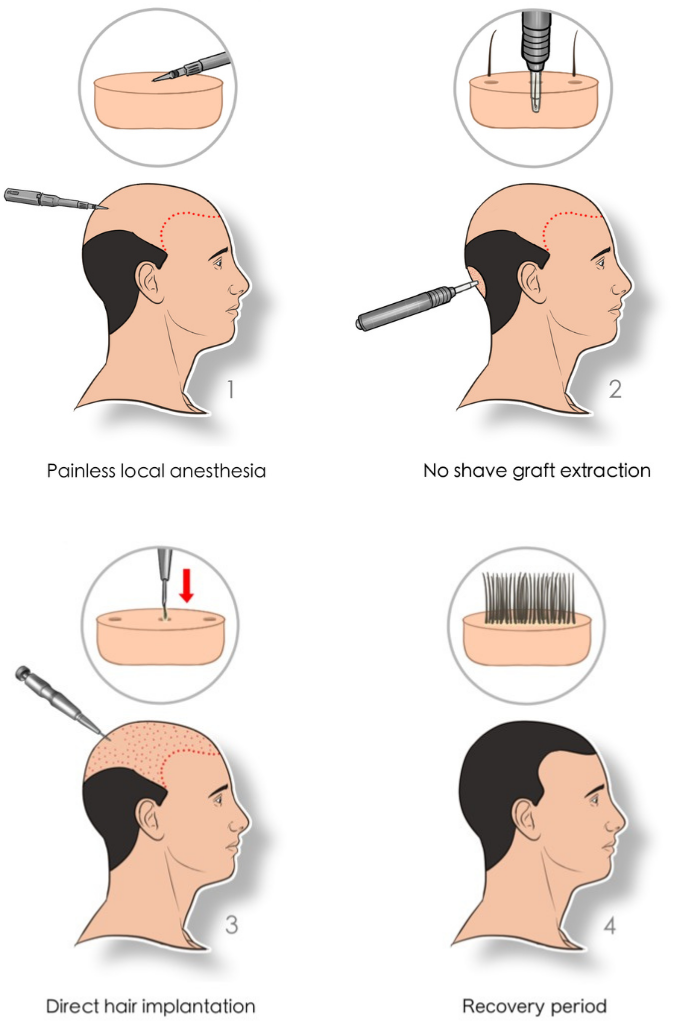DHI Hair Transplant Method
DHI Hair Transplant Method (Direct Hair Implanttation) The Direct Hair Implantation (DHI) method is a type of hair transplant procedure that involves the use of a specialized tool called a Choi pen. With the DHI method, hair follicles are removed one at a time from the donor area (usually the back of the head) and are immediately implanted into the recipient area using the Choi pen, which creates tiny incisions in the scalp for each hair follicle.
The DHI method is different from other hair transplant methods, such as follicular unit transplantation (FUT) and follicular unit extraction (FUE), which involve removing a strip of scalp or individual hair follicles and implanting them into the recipient area.

The advantages of the DHI method include:
- Minimal scarring: The tiny incisions made with the Choi pen are less noticeable than the larger incisions made with other methods.
- Shorter healing time: Because the incisions are small, there is less damage to the scalp, and the healing time is shorter.
- Precise hair placement: The Choi pen allows for precise hair placement, which can result in a more natural-looking hairline.
- Minimal discomfort: The DHI method is generally less painful than other methods, as there is less trauma to the scalp.
As with any hair transplant method, the success of the DHI method depends on various factors, such as the skill and experience of the surgeon and the quality of the donor hair. It’s important to consult with a qualified hair transplant surgeon to determine which method is best for you.

Are There Side Effects Harms?
Like any surgical procedure, hair transplantation may have some potential side effects and risks. However, most people who undergo hair transplantation do not experience any serious complications. Some of the possible side effects of hair transplantation may include:
- Swelling: It’s common to experience some swelling in the scalp after the procedure, which usually goes away within a few days.
- Pain: Mild discomfort or pain is normal after the procedure, but this can usually be managed with over-the-counter pain medication.
- Bleeding: There may be some minor bleeding at the donor and recipient sites, but this is usually temporary and stops on its own.
- Infection: Although rare, infection is a potential risk of any surgical procedure. Your doctor will provide you with instructions on how to care for your scalp after the procedure to minimize the risk of infection.
- Scarring: Like any surgery, hair transplantation may result in some scarring, but this is usually minimal and well hidden by the surrounding hair.
- Poor growth: In some cases, the transplanted hair may not grow as expected, or there may be uneven growth.
It’s important to discuss any potential risks and side effects with your doctor before undergoing the procedure, and to follow their instructions for post-operative care to minimize the risk of complications. Most people who undergo hair transplantation are able to resume their normal activities within a few days and see positive results within several months.
DHI Method (Direct Hair Implanttation), is a hair transplant technique in which individual hair follicles are extracted from a donor area and then immediately implanted into the recipient area, without the need for creating incisions or recipient sites. This method is intended to minimize trauma to the scalp and promote faster healing. The procedure is typically performed using a tool called a DHI implanter pen, which allows the surgeon to create precise, natural-looking hairline. The results of DHI hair transplantation can be very natural-looking, but it requires a great deal of skill and experience on the part of the surgeon to achieve optimal results.
DHI hair transplantation is considered a relatively new technique and is considered to be more advanced than traditional FUE (Follicular Unit Extraction) hair transplantation. The DHI method allows for greater precision in the placement of individual hair follicles, resulting in a more natural-looking hairline and density. Additionally, DHI is less invasive, with minimal scarring, pain, and post-operative recovery time.
The DHI method is generally recommended for those who want to address hair loss or thinning in specific areas, such as the hairline, temples, or crown. It’s also suitable for people who want to increase the density of their existing hair.
The procedure is typically performed under local anesthesia and can take several hours to complete, depending on the size of the area being treated. The transplanted hair typically begins to grow within 3-4 months, and the final result can be seen within 6-9 months.
It’s important to note that DHI Method (Direct Hair Implanttation) hair transplantation is not suitable for everyone and it’s important to consult with a qualified and experienced hair transplant surgeon to determine if this method is right for you. They will assess your medical history, scalp condition, and hair type, and recommend the best course of treatment for achieving your desired results.
Another advantage of DHI hair transplantation is that it allows for greater control over the direction and angle of hair growth, resulting in a more natural-looking final outcome. This is because the surgeon can use the DHI Method (Direct Hair Implanttation) implanter pen to precisely control the angle and direction of hair growth when implanting the individual hair follicles.
Additionally, DHI hair transplantation is considered to be more time-efficient than traditional hair transplant Antalya methods. The DHI method eliminates the need for creating recipient sites and allows for a faster procedure time.
It’s important to keep in mind that like any surgical procedure, there are some risks associated with DHI hair transplantation. These may include infection, bleeding, and scarring. However, these risks can be minimized by choosing a qualified and experienced hair transplant surgeon.
It’s also important to remember that DHI hair transplantation is not a permanent solution to hair loss. The transplanted hair will fall out within a few weeks, but then it will grow back naturally. And like any surgical procedure, it’s important to have realistic expectations of the results, while understanding that no hair transplant can guarantee 100% success.
In conclusion, DHI hair transplantation is a newer and advanced technique that can provide natural-looking results, with minimal pain, scarring, and recovery time. It’s essential to consult with a qualified and experienced hair transplant surgeon to determine if this method is right for you and to have realistic expectations about the results.
